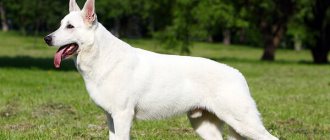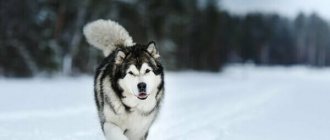The German Shepherd is a large service dog.
And every owner of a puppy of this breed is interested in whether his shepherd dog is growing and developing correctly.
Moreover, at exhibitions and training grounds, the dog owner can see his pet’s peers, who may be very different from his dog in height and physical development.
How much should a German Shepherd puppy weigh at each stage of its development and what weight and height will it have when it grows up?
What weight should an adult German Shepherd have depending on gender?
The weight of an adult male German Shepherd should be 30-40 kg, and that of a female – 22-32 kg . But there are also much larger and heavier individuals: for example, a male German Shepherd can weigh up to 50, and a female up to 35 kg.
A dog usually weighs from 23 to 38 kg per year. Starting from this age, its growth practically stops, but the dog continues to grow in width until the age of three: that is, it becomes more powerful and gains muscle mass.
A two-year-old shepherd weighs 23-40 kg and is already an almost fully formed adult animal..
From two to three years of age, the increase in body weight is insignificant, but by this age the dog should weigh, on average, 90 times more than it weighed at birth.
That is, a dog born with a body weight of 350 g should weigh about 31-32 kg at 3 years . And a dog that weighed 500 g at birth should weigh 45 kg by the age of three.
However, dogs may develop pathologies that impair development. Then the pet will grow less than normal.
When does one become an adult?
An adult dog is only spoken of when the pet reaches three years of age. Usually, by the age of three, the dog goes through all the stages of development, receives sufficient education and training, is socialized and gains the necessary height and weight. Over the past three years, the dog receives a formed exterior, which shows how well the dog corresponds to the standard description of the breed.
Many people mistakenly believe that the first heat in female dogs indicates that they have become adults. In fact, this is completely wrong. Professional dog handlers note that shepherd dogs can be bred only after the third heat. It is then that the bitch is ready to bear and accept offspring, performing all her maternal functions.
Dimensions according to standard
According to the breed standard , the height of a German Shepherd depending on gender should be :
- Males: 60-65 cm at the withers.
- Bitches: 55-60 cm at the withers.
At the same time, the body length in boys of this breed is 71-77 cm, and in girls - 61-70 cm.
The chest circumference of a German Shepherd is 83-87 cm in males and 77-82 cm in females.
Expert opinion
Tolkachev Andrey Mikhailovich
veterinarian
“The health of a German Shepherd and its working qualities depend not least on the weight of the dog. If a shepherd is overfed, its performance and endurance are greatly reduced. Underfeeding and too little weight are also harmful for representatives of this breed, since in this case the shepherd’s resistance to disease decreases. The weight and size of the German Shepherd must be within the standard and be harmonious in relation to each other.”
Prenatal period of development
Before being born, a German Shepherd puppy goes through stages of intrauterine development. At this time, the formation of a small organism occurs. The pet inherits the external features of its parents, their build, type of psycho-emotional behavior, ability to train and raise.
Pregnant German Shepherd
During the period when a pet's mother is pregnant, it is very important to provide her with proper care and maintenance. She must be completely healthy. Typically, the gestation period for German Shepherds lasts up to 50-60 weeks. It depends on him whether the pet will be born healthy and strong, whether he will lag behind in development, and what characteristics will be inherent to him.
These dogs are born with a body weight of 300 – 600 grams.
Weight and dimensions of a newborn puppy
On average, the weight of a newborn male is 500 g, females are born weighing from 350 g . But this is the average litter size of 6-8 puppies.
If a small number of shepherd puppies were born - 3-4, then their weight, regardless of gender, will be equal to 450-500 g. In a large litter, from 8 to 12 puppies, it, also regardless of the gender of the babies born, will be slightly smaller and will be approximately 350-450 g.
The length of newborn German Shepherd puppies is 18-22 cm.
Musculoskeletal system
The spine is the basis of the body; the rest of the dog’s proportions depend on its ratio.
With an exact correspondence of length and symmetry to height, the bones form an excellent motor system. There is a feeling of movement, devoid of tension. When running serenely, the dog's limbs move in a diagonal progression, forming a continuous line from the end of the tail to the end of the ears.
The heights are combined as follows: the front legs move the same distance as the hind legs, approximately to the middle of the body. Any shift in the hind paw reduces stability and strength.
Puppy weight and sizes for male and female by month from 1 to 12 months (table)
| Age by month | Height at withers for males (cm) | Height at withers in bitches (cm) | Weight for males (g) | Weight in bitches (g) |
| 1 month | 20-21 | 19-20 | 3.500-4.200 | 3.000-3.300 |
| 2 months | 35-38 | 32-35 | 8.500-9.000 | 7.500-8.000 |
| 3 months | 44-48 | 40-44 | 14.000-14.200 | 12.000-12.300 |
| 4 months | 52-57 | 47-52 | 19.000-20.000 | 16.000-16.400 |
| 5 months | 54-58 | 51-54 | 22.000-22.900 | 20.000-21.700 |
| 6 months | 56-60 | 52-56 | 24.000-26.000 | 22.500-23.000 |
| 7 months | 57-61 | 53-57 | 28.000-28.400 | 23.000-24.700 |
| 8 months | 57-61 | 53-57 | 29.000-30.000 | 25.000-25.200 |
| 9 months | 57-61 | 53-57 | 30.500-32.000 | 26.100-26.500 |
| 10 months | 58-62 | 54-58 | 32.900-33.300 | 27.000-27.500 |
| 11 months | 58-62 | 54-58 | 33.000-33.500 | 28.000-29.000 |
| 12 months | 59-63 | 55-59 | 33.000-34.000 | 30.000-32.000 |
Limbs
Front end
Examination from any side shows that the front feet are straight and have round, strong pads with strong nails. When viewed from the front, you can see that the legs are parallel. On the long shoulder are smooth, powerful shoulder blades and shoulder levers. The ideal angle between them is 90 degrees, 110 degrees is acceptable.
The length is slightly greater than the height, somewhere around 55-58%. The elbows are pressed to the chest and set straight back. When moving, or in a position of rest, they cannot be twisted or shifted.
The proportional, strong forearm forms a slope of 20-22 degrees. If the slope is less than 20 degrees, then this has a negative impact on durability and quality.
Disadvantages: Extremely vertical stance of the forelimbs is a flaw.
Rear end
When viewed from behind, the legs are straight and slightly set back beyond the line of the ischial tuberosities. Muscular, equal shins, connecting to the thigh, form a knee angle of 120 degrees. Well defined hock joints are strong and set low. The oval, compact feet have dark, durable pads with strong nails. At an early age, dewclaws are eliminated.
Disadvantages: The right angle of the joints is considered a defect.
To what age do they grow?
The most intensive growth of a German Shepherd puppy occurs in the first month of life. By the tenth day of life, the weight of babies doubles, so that the weight of males reaches 1 kg, and girls at this age weigh approximately 800 g.
NOTE!
Further growth occurs no less quickly: by the 18th day, shepherd puppies, depending on gender, weigh from 1.8 to 2 kg, and by a month they already weigh 3-3.5 kg.
Later, between two and six months, weight gain slows down.
From 1 to 2 months, the German Shepherd's weight doubles again, but further weight gain does not occur as quickly. But by the age of six months, the puppy already weighs approximately 2/3 of the weight of an adult dog.
The growth of a German Shepherd continues on average for up to a year, and puppies grow fastest until they are six months old.
During the first five months of life, puppies grow by about 10 cm every month, so that by this age their height is already 51-58 cm. From 5 to 6 months, the dog’s growth slows down sharply and the dog grows by about 3 cm per month.
By the age of 10-12 months, the German Shepherd almost reaches its maximum height and practically no longer grows in height..
But at the same time, after 1 year, a dog of this breed still continues to gain muscle mass and increase weight, and this continues until approximately the age of three.
In order for the pet to grow and develop correctly, it is very important to avoid early matings, not only in females, but also in males, since after this the animal’s growth stops very quickly.
Some owners, afraid that their dog will grow too large and therefore not meet the requirements of the standard, deliberately try to untie him as soon as possible.
This should not be done under any circumstances, since after early matings not only the dog’s growth slows down, but also its overall physical and mental development..
The growth of bitches also slows down after the first heat. This does not mean that the dog will now not be able to reach the required height before 12 months, but its growth will now not occur as quickly as in the first months of the puppy’s life.
At what age is a dog considered old?
From about 6 years old, a shepherd dog is considered mature. You can tell how old your pet is by looking at its teeth. Usually they are already noticeably yellow, the tubercles on them are completely erased. In addition, some pets change color, becoming piebald.
Most people might think that the dog has turned grey, since the main color of the coat becomes lighter, frankly light spots appear over the entire surface of the body, like gray hair in a person. In fact, the pigment simply leaves the wool, causing it to lose color saturation.
The German Shepherd is a companion and an excellent watchdog. The meaning of this dog's life is work; it cannot become just a lap dog. Active exercises, training and constant stress should be the key to health and prolong the life of your pet.
Similar articles
When a person gets a German Shepherd puppy, he is, of course, interested in how old these animals grow and what size they become when they finally grow up.
We will look at these issues in detail in this article.
The influence of various factors on the pet’s parameters
A variety of factors can influence a puppy's height and weight, such as:
- Heredity . Dogs of some lines grow larger, while others grow smaller in size. In addition, the rate of height and weight gain may also depend on heredity.
- Intrauterine development . If the puppy’s mother ate properly during pregnancy and was kept in good conditions, then her babies received all the vitamins and minerals they needed. They gained good weight and height at the time of birth, and therefore had all the makings for normal physical development.
- Sucking period . The conditions for keeping and feeding babies in the breeder’s home are very important. If the lactating bitch ate well, and the puppies were started on time and fed correctly, then by the time of activation and subsequent sale they will have good height and weight, and their psychological and physical development will be appropriate for their age.
- Quality of feeding. Often, lack of height or weight in dogs is due to the fact that the dog is malnourished, which is why it regularly does not get the vitamins, microelements and other nutrients it needs.
- Content. If a German Shepherd puppy is constantly sitting in an enclosure or on a chain and is not being handled, trained or walked, then it simply will not have the opportunity to develop physically. The same applies to city dogs, which are kept in apartments and taken outside only for a few minutes a day.
- Diseases. If a puppy or young dog has suffered from a serious infectious disease, its growth may be stunted or even stop completely. The presence of internal parasites can also negatively affect a dog’s height and weight.
In order for a shepherd puppy to grow up strong and healthy, so that it does not suffer from infections due to which it may subsequently stop growing, it is necessary to give it all the necessary vaccinations on time and protect it from contact with sick animals.
Period of rapid growth
The period of rapid growth in dogs begins at 8 weeks and ends with six months of life. At this stage of development, the dog is actively growing and maturing.
In addition, the following important events occur in the life of a little tailed lump:
- The pet learns to socialize in the company of the owner, strangers and other animals;
- The pet masters the first skills in education and training;
- The dog's milk teeth are replaced by permanent ones;
- The animal's ears begin to gradually acquire the correct erect position;
- The puppy's height and weight increase at tremendous speed.
From this time on, the owner is responsible for the development of the pet. It is the owner who can influence the socialization of the animal and its psychological behavior. The height of the puppy at the withers during the period of rapid growth increases up to 60 centimeters, and the weight ranges from 18 to 30 kilograms.
What to do if it lags behind the norm
First of all, do not worry if we are talking about a puppy or a young dog that has not reached the age of three, and its weight loss does not exceed 10-15%.
The fact is that all dogs develop differently, and a shepherd dog that is still growing may experience slight weight gain.
However, this is a reason to think about the fact that it would be nice to change something in the conditions of keeping or feeding the pet.
It may make sense to start paying more attention to walks and exercise to help your young dog gain muscle mass faster. Or maybe it would be worth increasing the amount of protein and fermented milk products in her diet.
In addition, to make sure that underweight is not caused by genetic reasons, it is advisable for the owner to find out from his breeder how the puppy’s mother and his other relatives kept in the kennel developed.
It is possible that dogs of this line simply mature late and gain weight slowly.
CAREFULLY!
There is no need to try, on the advice of some “experts” from among friends and relatives who are far from dog breeding, to feed a shepherd dog with drugs to quickly gain muscle mass or force it to carry heavy weights during its growth period.
In this case, it is easy not only to overload the dog, which will make it too heavy and massive for a standard shepherd, but it can also cause irreparable harm to its health.
How character changes
To raise a healthy and psychologically stable dog, in addition to weight, you need to worry about its socialization and education. In the life of a puppy, there are several important stages of character change that every self-respecting breeder should know about.
German Shepherd training
- 2 months. Introducing the puppy to its new family. At this time, the shepherd's learning ability is at a high level, so the owner should start teaching basic commands. At this time, puppies are quite vulnerable, so any training should be accompanied by love and patience. If the puppy does not obey, he should be punished as his mother would have done it. To do this, the owner must take the puppy by the withers and press him to the floor, saying the command “fu!” When it comes to socialization, it can be helpful to give your pet the opportunity to interact with other dogs.
- 4 months. This stage implies the formation of a hierarchy. If a puppy starts biting or grinning, he is trying to determine who is in charge in the family: the owner, his family members, or him. It is important for him to understand that he is on the lower rung after his family. Lack of proper upbringing will allow the puppy to take a leading position, which will have a negative impact in the future.
- 5 months. The main tasks of this period are training and proper education. Males may begin to show the first signs of heat by jumping on their feet. If the dog is planned to be used for breeding, you cannot scold for these movements; it is better to carefully distract the puppy with a toy.
- 6 months. The time for self-assertion of a raised shepherd dog. Owners may encounter reluctance to follow commands and other disobedience on the part of the pet. In this case, you should behave calmly and try to prevent possible antics. It is also important to give the dog enough attention.
- 7-12 months. Dogs often become fearful or nervous in situations that were previously familiar to them. This behavior is not caused by genetic predisposition or errors in upbringing; it is a natural stage in the development of an adult shepherd dog.
- 1-4 years. Time for the final formation of character and protective instinct.
Important! Each stage requires a competent approach. Proper upbringing and care from the owners will turn the puppy into a devoted friend and guard.
Difficulties of care
In fact, the breed does not have any special needs. The main thing is a good diet and care. The coat needs to be cared for in the same way as most dogs. That is, comb the puppy with specialized brushes. When the dog grows up, you need to use combs for combing.
You can bathe, especially if the dog is kept in an apartment or lives in a house. Vaccination according to age is mandatory for all pets, including German Shepherds. Information about vaccinations can be obtained from the breeder and veterinarian.
What time do your ears stand up?
Ears begin to stand up between 1.5 months and 5 months.
Over time, the cartilage strengthens and the ears become larger. The change of teeth is directly related to the formation of the ears, so they can stand up at 2 months, and fall again by 3 months. Observe the ears carefully from 5 to 6 months; if they are not erect by the age of six months, contact your veterinarian. After 7 months it is very difficult to place ears.
Why isn't this happening?
There are a number of reasons why German Shepherds' ears don't stand up:
- Not purebred shepherd. People are often deceived and sold non-purebred puppies. Such animals often have problems with the formation of ears. When purchasing, carefully check all documents for the dog.
- Insufficient amount of minerals. With poor nutrition and lack of essential substances, cartilage may not form properly.
- Ear diseases. Any inflammation can negatively affect the performance.
- Irregular fit or structure of the ears. Let's say the ears are very large and large or, on the contrary, thin. In this case, in order not to harm the animal, seek help from a veterinarian.
- Weak immunity and frequent illnesses. If your pet is often sick, he may not have enough nutrients to form cartilage.
How to install?
If your pet is more than 4 months old, and the ears are not set and are quite flaccid, you need to take action.
- Massage the ears. Massage stimulates blood circulation, which will have a positive effect when performing.
- Sound. Unusual and unexpected sounds will attract the puppy's attention, and he will turn around and raise his ears fully for a while. Thanks to such training, the muscle tissue of the auricle will be strengthened and over time it will completely move to a vertical position.
- Balanced diet. If the dog lacks nutrients, then cartilage will not develop. The menu must include: fish, dairy products.
- Introduce fertilizers with sufficient amounts of microelements.
- Glue the ears. You will need foam rollers without plastic inserts and a patch. Try to choose a curler based on the size of your ear, as too large or small will bring less benefit. Insert the foam rubber into the auricle without covering the ear canal, secure with adhesive tape. Do not use tape - it can injure the puppy's skin. The structure must be removed after seven days. If there are no changes, repeat the procedure.
Important! If, after taking measures, the ears still do not stand up by 6 months, contact your veterinarian.
Tips for the owner
- It is necessary to communicate with the puppy during the period of its socialization. He must feel the “leader” and be friends with members of the “pack” - people or other animals.
- The shepherd dog should not be prevented from exploring objects, places, or animals to gain skills. They will help develop the characteristic traits of the breed (tolerance, resistance to stress).
- The process of raising and training a puppy should begin from puppyhood.
- It is advisable to monitor the dog’s physiological indicators according to the norms. Minor deviations are possible.
- The animal must have 2 bowls (for food and water).
- It is necessary to be present with the dog when feeding.
The German Shepherd is a working breed of dog. Its distinctive features are balance, strength, and agility. And for the animal to show them in the future, the owner needs to study all stages of development, the norms of the puppy’s parameters and monitor his health.
Sources
- https://provsehsobak.ru/krupnye-porody-sobak/nemeckaya-ovcharka/rost-i-ves-po-mesyatsam.html
- https://domashnij-zapovednik.com/sobaki/porody-s/nemeckaya-ovcharka/ves-sobaki.html
- https://umnayasobaka.com/porody/bolshie/nemeckaya-ovcharka/schenok.html
- https://ovcharkin.ru/osobennosti/rost-i-ves-nemetskoj-ovcharki.html
- https://gafki.ru/sobaki/ves-nemetskoy-ovcharki.html
- https://MurashDom.ru/zdorove/ves-ovcharki.html
- https://dogzy.ru/veterinariya/ves-nemeckoj-ovcharki-po-mesyacam.html
[collapse]
Wool
The rough hair on the head is shorter and softer to the touch than on the legs, toes, neck and back of the ears. On the hips it forms something like pants.
The coat of a real German comes in three types:
- normal coat;
- long-haired breeding dog;
- long-haired shepherd dog.
Disadvantages: Too thick, long coat is considered a fault. Especially on the tail.











